picspam: top 10 photos that changed a nation
1. "The Last Spike"
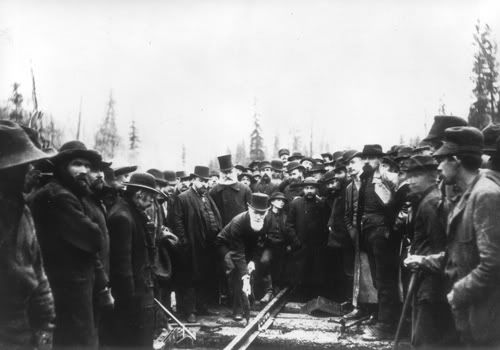
photo by: Alexander J. Ross
Described by some as "an emblem of national unity", this photo memorializes the final iron spike driven into the railway that linked the eat with the west. CPR director Donald Smith bent his first attempt and pocketed the rail, eventually using it to make a diamond-encrusted brooch for his wife. After his second try on November 7, 1885, the CPR Director stated: "All I can say is that the work has been done very well in every way." How very Canadian.
2. "Wait for Me, Daddy"
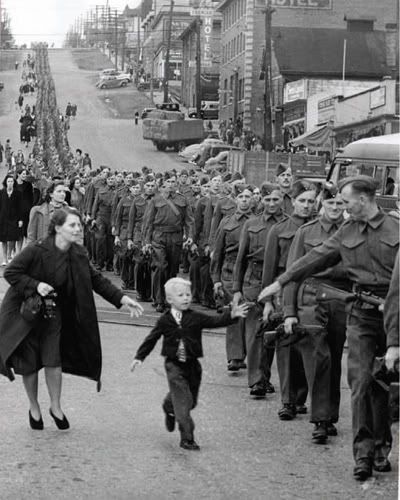
photo by: Claude Detloff
Taken on Eighth Street in New Westminder, B.C. on October 1st 1940, this photo captures one fleeting moment similar to of dozens of similar processions - with the exception of the little boy struggling to reach his father. The photo represents "the personal sacrifice many soldiers made to serve their country." The picture made the cover of The Province, Maclean's Time, Encyclopedia Britannica Yearbook, countless other newspapers and Life's ten best images of the 1940's.
3. "Henderson's Goal"

photo by: Frank Lennon
This snapshot of Paul Henderson celebrating the game-winning goal with 34 seconds left on the clock saves the moment that made Canadian fans leap out of their seats as Canada finally won the legendary 1972 Summit Series in Moscow. As Canada's own personal (Ice) Cold War, the nation was united in excitement, and disappointment, when the best NHL players didn't immediately sweep the Big Red Machine. Seen by many as the most important game with the greatest hockey team of the twentieth century, this image has won a Canadian Press Picture of the Year Award and has been reproduced as a coin, postage stamp, posters and on countless hockey cards.
4. "Terry's Journey"
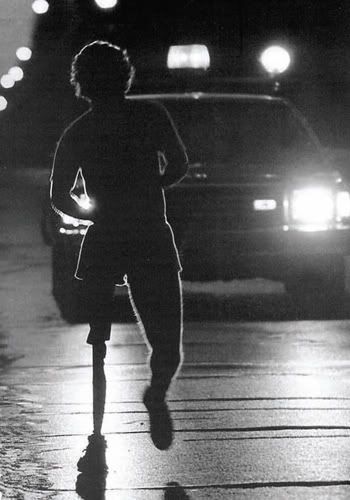
photo by: Peter Martin
The image of Terry Fox silhouetted by headlights on an early summer morning in 1980 evokes the awe and sentiment Canadians still hold for Terry. It delivers the sense of his unwavering determination he showed during those inspiring months of the Marathon of Hope. He began in St. John's, Newfoundland and ended on September 1 outside of Thunder Bay, Ontario. The cancer had spread and forced him to abandon his cross-country run. But hope has not died, the annual Terry Fox run has collected $400 million for cancer research. "This photo catches the triumph of the spirit of a man to overcome his physical limitations and achieve greatness. But this portrait also tells another side of Terry's story. While bathing him in a halo of light, it leaves a dark shadow before him, one that he would face on June 28, 1981. He died at the age of twenty-two."
5. "Standoff at Oka"
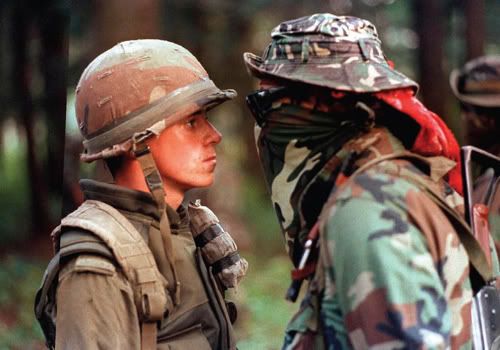
photo by: Shaney Komulainen
This image brings to mind destruction and near civil war on Canadian soil. It captures the historic anger felt by Canada's aboriginal people and reveals the challenge of balancing two societies. Canadian soldiers and armed Mohawk warriors stared each other down in the trees outside the contested property (that the town wanted to extend their golf course on land considered to be traditional burial grounds by the Mohawks). It was a wake up call to millions of Canadians that all was not well. In July 1990, tear gas and gunshots were exchanged. After the gas and confusion settled, Corporal Marcel Lemay lay dead. "Sadly, this photo reflects the deep divide this country still experiences with it's aboriginal peoples." (On September 26, 1990, the final barricade came down and thirty-four Mohawks were arrested. The disputed area is now an extension of the Mohawk cemetery.)
6. "Over the Top Forgery"

photo by: William Ivor Castle
William Ivor Castle was appointed Canada's official war photographer by the Canadian War Records Office during World War I. He was to document battles in France. The heroic image stood as a testament to Canadian involvement in the Great War, but like most propaganda, his images didn't tell the truth. But this famous photo of troops supposedly taken at the Battle of Somme, was actually taken during a training exercise. Smoke was added for effect. However, despite uncovering the fraud, the image of troops 'going over the top' is still an iconic one and recognised today as one of the quintessential wartime photos.
7. "Canada's Miracle Babies"

photo by: Unknown
Depression-weary Canadians were overjoyed at the chance to revel in something - the world's first surviving quintuplets. Born to a poor Quebec couple that couldn't afford to feed them, the five Dionne sisters were embraced as wards of the state in 1934 by Ontario Premier Mitchell Hepburn. The quints, as they were called, lived for years in a special hospital (although it was really little more than a 'human zoo'). About three million people watched the quints play in a fenced-off enclosure, becoming Canada's largest tourist attraction.
8. "Trudeau: Family Man"

photo by: Rod MacIvor
Prime Minister Pierre Trudeau was making headlines with groundbreaking visits to China and Cuba in 1973, but amidst the political bustle, he was captured in this photo as a family man. The picture displays his charisma and confidence during this stage of his career. Trudeau was simultaneously loved, admired and detested by some, but there's no denying his impact on Canada.
In fact, I feel like I'd either have to write a looong paragraph on him to do his political career justice; both positive and negative. He's certainly the most interesting politician Canada has seen yet. To save time: wikipedia, cbc: best Canadian? & ctv: worst Canadian?. But I strongly urge you to check him out. He dated celebrities and did a pirouette behind the back of the Queen of England! Oh, and reformed the Criminal Code to keep the gov't out of the nation's bedroom and established the Charter of Rights and Freedoms within Canada's constitution. Ch-ch-check it out!
9. "A Terrible Turning Point"
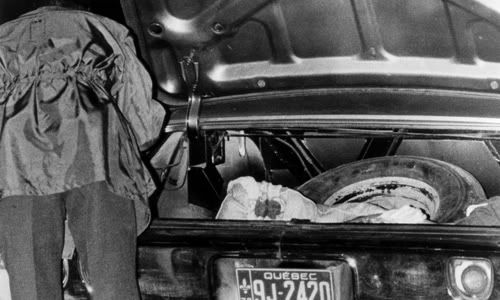
photo by: Robert Nadon
At the height of the October Crisis of 1970 a tip gave the police the location of the Labour and Immigration Minister (Pierre Laporte). Laporte had been strangled and stuffed into the the trunk of a car at the St. Hubert Airport south of Montreal one week after he was kidnapped by FLQ (Front de liberation du Quebec) terrorists in Montreal. After the grisly photo was published, the FLQ lost much of the sympathy it had gained among nationalist Quebecers. The incident led police to use extreme measures; conducting more than 5,000 searches and raids and arresting nearly 500 people.
10. "Stanfield's Political Stumble"
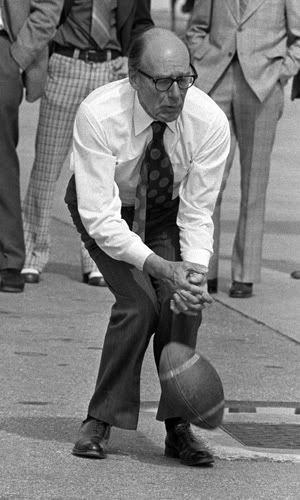
photo by: Doug Ball
Warning: to all politicians staging a photo-op, don't screw up. In May of 1974, the Progressive Conservative leader Robert Stanfield grimaced as he dropped a football while campaigning in North Bay, Ontario for the Federal election. The photographer had several similar photos with the PC leader successfully throwing and receiving the football, but since this photo was the one published, it strengthened the image of an awkward man with an unsteady campaign. The Liberals were returned to power with 141 seats to 95 for the Conservatives on July 8.
**All of these photos (and much of the commentary) are from The Beaver: Canada's History Magazine. You can find it in the August/September issue of 2008 or online from many sources.